A Fully Inkjet-Printed Strain Sensor Based on Carbon Nanotubes
Abstract
:1. Introduction
2. Experiments
3. Results and Discussion
3.1. Characteristics of Inkjet-Printed CNTs
3.2. Electrical Properties of Strain Sensors
4. Conclusions
Author Contributions
Funding
Acknowledgments
Conflicts of Interest
References
- Kanoun, O.; Müller, C.; Benchirouf, A.; Sanli, A.; Dinh, T.N.; Al-Hamry, A.; Bu, L.; Gerlach, C.; Bouhamed, A. Flexible carbon nanotube films for high performance strain sensors. Sensors 2014, 14, 10042–10071. [Google Scholar] [CrossRef] [PubMed] [Green Version]
- Slepchenkov, M.M.; Glukhova, O.E. Mechanical and electroconductive properties of mono- and bilayer graphene–carbon nanotube films. Coatings 2019, 9, 74. [Google Scholar] [CrossRef] [Green Version]
- Andrews, J.B.; Cardenas, J.A.; Lim, C.J.; Noyce, S.G.; Mullett, J.; Franklin, A.D. Fully printed and flexible carbon nanotube transistors for pressure sensing in automobile tires. IEEE Sens. J. 2018, 18, 7875–7880. [Google Scholar] [CrossRef]
- He, Z.; Byun, J.-H.; Zhou, G.; Park, B.-J.; Kim, T.-H.; Lee, S.-B.; Yi, J.-W.; Um, M.-K.; Chou, T.-W. Effect of MWCNT content on the mechanical and strain-sensing performance of Thermoplastic Polyurethane composite fibers. Carbon 2019, 146, 701–708. [Google Scholar] [CrossRef]
- Amjadi, M.; Yoon, Y.J.; Park, I. Ultra-stretchable and skin-mountable strain sensors using carbon nanotubes-ecoflex nanocomposites. Nanotechnology 2015, 26, 375501. [Google Scholar] [CrossRef] [PubMed]
- Yee, M.J.; Mubarak, N.M.; Khalid, M.; Abdullah, E.C.; Jagadish, P. Synthesis of polyvinyl alcohol (PVA) infiltrated MWCNTs buckypaper for strain sensing application. Sci. Rep. 2018, 8, 17295. [Google Scholar] [CrossRef]
- Bu, L.; Steitz, J.; Kanoun, O. Influence of processing parameters on properties of strain sensors based on carbon nanotube films. In Proceedings of the International Multi-Conference on Systems, Signals and Devices, Amman, Jordan, 27–30 June 2010. [Google Scholar]
- Lee, D.; Park, C.W.; Min, N.K. Microfabrication of spray-coated SWCNT film strain gauges. In Proceedings of the International Conference on Nanotechnology, Portland, OR, USA, 15–19 August 2011; pp. 166–171. [Google Scholar]
- Sahatiya, P.; Badhulika, S. Eraser-based eco-friendly fabrication of a skin-like large-area matrix of flexible carbon nanotube strain and pressure sensors. Nanotechnology 2017, 28, 095501. [Google Scholar] [CrossRef]
- Chun, S.; Son, W.; Choi, C. Flexible pressure sensors using highly-oriented and free-standing carbon nanotube sheets. Carbon 2018, 139, 586–592. [Google Scholar] [CrossRef]
- Chen, S.; Li, Y.; Lin, Y.; He, P.; Long, T.; Deng, C.; Chen, Z.; Chen, G.; Tao, H.; Lan, L.; et al. Inkjet-printed top-gate thin-film transistors based on InGaSnO semiconductor layer with improved etching resistance. Coatings 2020, 10, 425. [Google Scholar] [CrossRef]
- Cho, C.-L.; Kao, H.-L.; Chang, L.-C.; Wu, Y.-H.; Chiu, C.-H. Inkjet-printed vertical interconnects for ultrathin system-on-package technology. Surf. Coat. Technol. 2019, 359, 85–89. [Google Scholar] [CrossRef]
- Qin, Y.; Kwon, H.-J.; Subrahmanyam, A.; Howlader, M.M.R.; Selvaganapathy, P.R.; Adronov, A.; Deen, M.J. Inkjet-printed bifunctional carbon nanotubes for pH sensing. Mater. Lett. 2016, 176, 68–70. [Google Scholar] [CrossRef]
- Yan, X.; Shi, K.; Chu, X.; Yang, F.; Chi, Y.; Yang, X. Stepped annealed inkjet-printed InGaZnO thin-film transistors. Coatings 2019, 9, 619. [Google Scholar] [CrossRef] [Green Version]
- Schneck, M.; Gollnau, M.; Lutter-Günther, M.; Haller, B.; Schlick, G.; Lakomiec, M.; Reinhart, G. Evaluating the use of additive manufacturing in industry applications. Procedia CIRP 2019, 81, 19–23. [Google Scholar] [CrossRef]
- Jiménez, M.; Romero, L.; Dominguez, I.A.; Espinosa, M.D.M.; Dominguez, M. Additive manufacturing technologies: An overview about 3D printing methods and future prospects. Complexity 2019, 2019, 1–30. [Google Scholar] [CrossRef] [Green Version]
- Assadi, H.; Gärtner, F. Compression test: A key step towards tailoring of feedstock powder for cold spraying. Coatings 2020, 10, 458. [Google Scholar] [CrossRef]
- Tang, Z.; Yao, D.; Hu, S.; Du, D.; Shao, W.; Tang, B.; Fan, J.-M.; Tang, X.-G.; Gao, J. Highly conductive, washable and super-hydrophobic wearable carbonnanotubes e-textile for vacuum pressure sensors. Sens. Actuators A Phys. 2020, 303, 111710. [Google Scholar] [CrossRef]
- Srivastava, R.K.; Vemuru, V.S.M.; Zeng, Y.; Vajtai, R.; Nagarajaiah, S.; Ajayan, P.M.; Srivastava, A. The strain sensing and thermal–mechanical behavior of flexible multi-walled carbon nanotube/polystyrene composite films. Carbon 2011, 49, 3928–3936. [Google Scholar] [CrossRef]
- Tortorich, R.P.; Choi, J.-W. Inkjet printing of carbon nanotubes. Nanomaterials 2013, 3, 453–468. [Google Scholar] [CrossRef] [Green Version]
- Gutierrez, S.M.V.; He, Y.; Cao, Y.; Stone, D.; Walsh, Z.; Malhotra, R.; Chen, H.-L.; Chang, C.-H.; Robinson, S.C. Feasibility and surface evaluation of the pigment from scytalidium cuboideum for inkjet printing on textiles. Coatings 2019, 9, 266. [Google Scholar] [CrossRef] [Green Version]
- Soum, V.; Park, S.; Brilian, A.I.; Kim, Y.; Ryu, M.Y.; Brazell, T.; Burpo, F.J.; Parker, K.K.; Kwon, O.-S.; Shin, K. Inkjet-printed carbon nanotubes for fabricating a spoof fingerprint on paper. ACS Omega 2019, 4, 8626–8631. [Google Scholar] [CrossRef]
- Kim, T.; Song, H.; Ha, J.; Kim, S.; Kim, D.; Chung, S.; Lee, J.; Hong, Y. Inkjet-printed stretchable single-walled carbon nanotube electrodes with excellent mechanical properties. Appl. Phys. Lett. 2014, 104, 113103. [Google Scholar] [CrossRef]
- Zhao, Y.; Beisteiner, C.; Gschossmann, S.; Schagerl, M. An inkjet-printed carbon nanotube strain distribution sensor for quasi real-time strain monitoring of lightweight design materials. Adv. Sci. Technol. 2016, 101, 3–8. [Google Scholar] [CrossRef]
- Dinh, N.T.; Sowade, E.; Blaudeck, T.; Hermann, S.; Rodriguez, R.D.; Zahn, D.R.T.; Schulz, S.E.; Baumann, R.R.; Kanoun, O. High-resolution inkjet printing of conductive carbon nanotube twin lines utilizing evaporation-driven self-assembly. Carbon 2016, 96, 382–393. [Google Scholar] [CrossRef]
- Michelis, F.; Bodelot, L.; Bonnassieux, Y.; Lebental, B. Highly reproducible, hysteresis-free, flexible strain sensors by inkjet printing of carbon nanotubes. Carbon 2015, 95, 1020–1026. [Google Scholar] [CrossRef] [Green Version]
- CLTE-MW™ Laminates. Available online: https://rogerscorp.com/-/media/project/rogerscorp/documents/advanced-connectivity-solutions/english/data-sheets/clte-mw-laminates-data-sheet.pdf (accessed on 14 August 2020).
- Muller, R.M.; Conragan, J. A Metal-insulator-piezoelectric semiconductor electromechanical transducer. IEEE Trans. Electron. Devices 1965, 12, 590–595. [Google Scholar] [CrossRef]
- Kwon, O.-S.; Kim, H.; Ko, H.; Lee, J.; Lee, B.; Jung, C.-H.; Choi, J.-H.; Shin, K. Fabrication and characterization of inkjet-printed carbon nanotube electrode patterns on paper. Carbon 2013, 58, 116–127. [Google Scholar] [CrossRef]
- Li, X.; Levy, C.; Elaadil, L. Multiwalled carbon nanotube film for strain sensing. Nanotechnology 2008, 19, 045501. [Google Scholar] [CrossRef]
- Strain Gage Technical Data. Available online: https://www.omega.co.uk/techref/pdf/STRAIN_GAGE_TECHNICAL_DATA.pdf (accessed on 14 August 2020).
- Strain Gages. Available online: http://spectromas.ro/wp-content/uploads/2018/10/S01265.pdf (accessed on 14 August 2020).
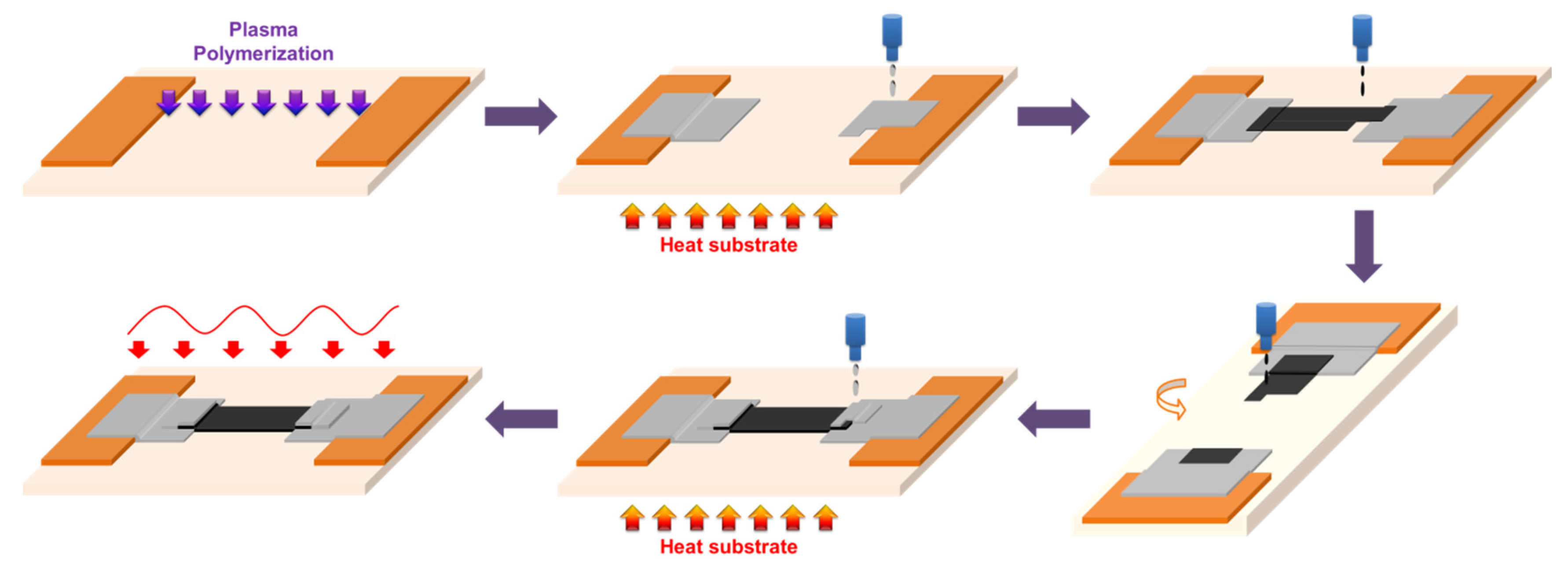

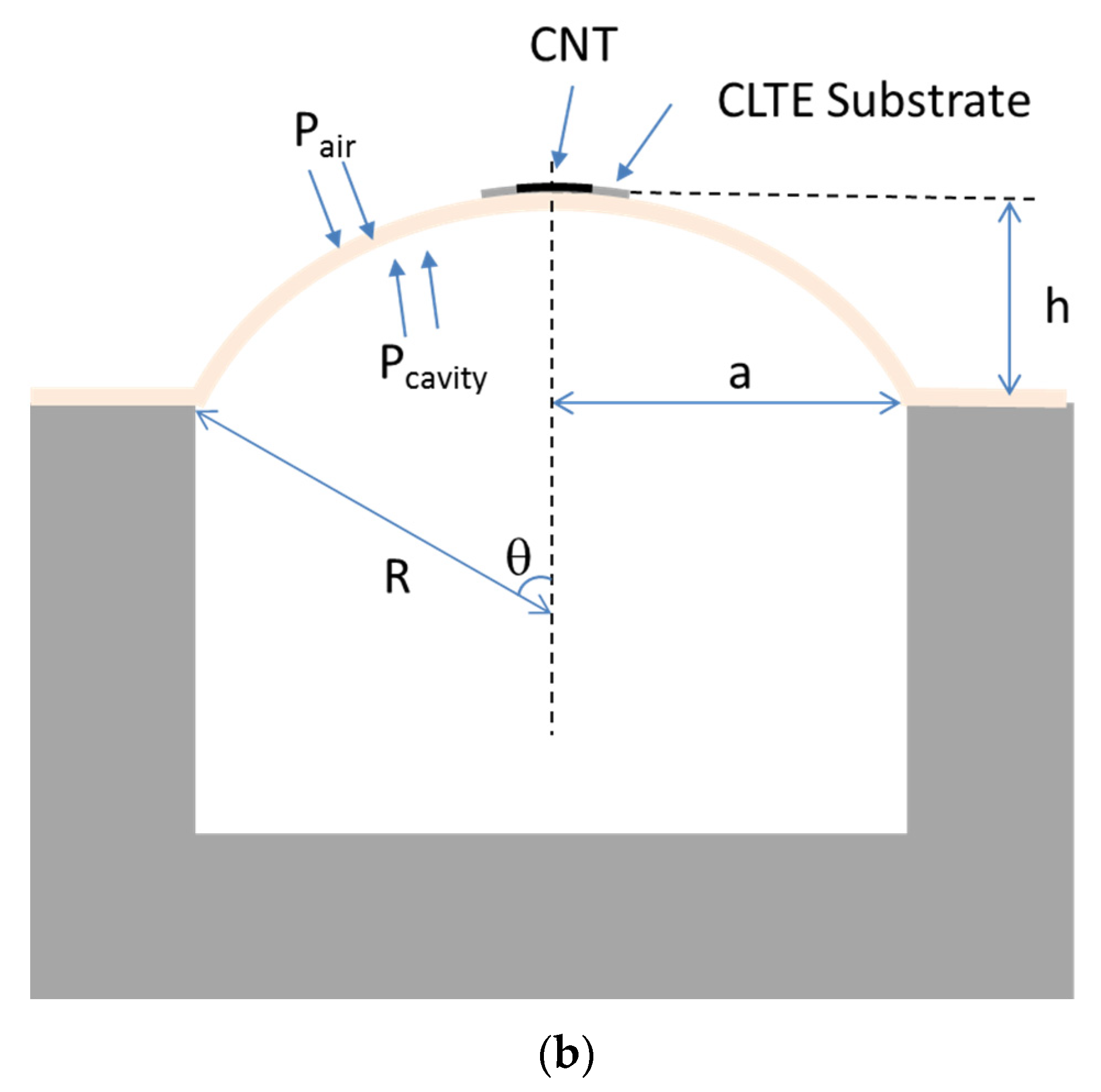
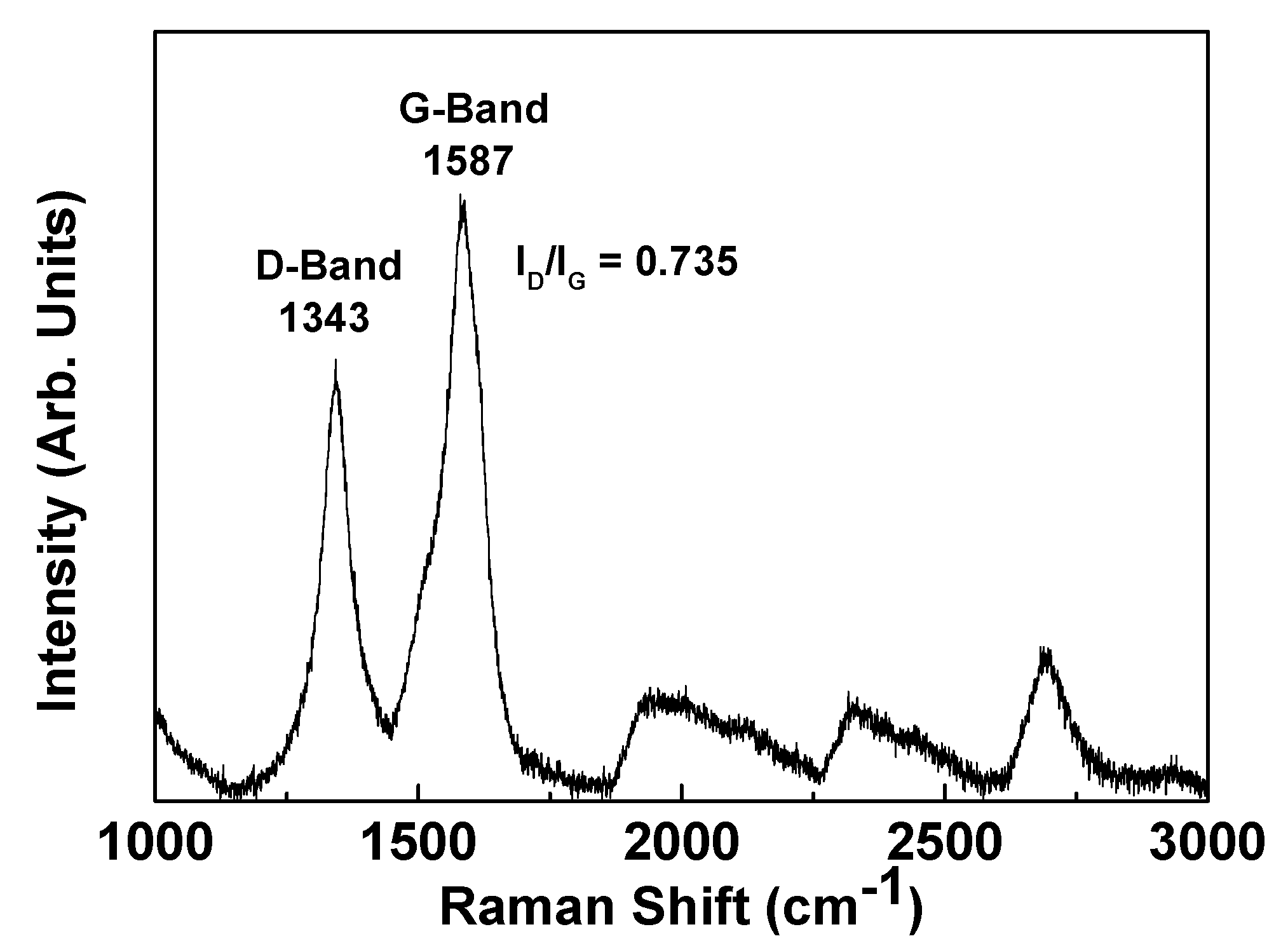
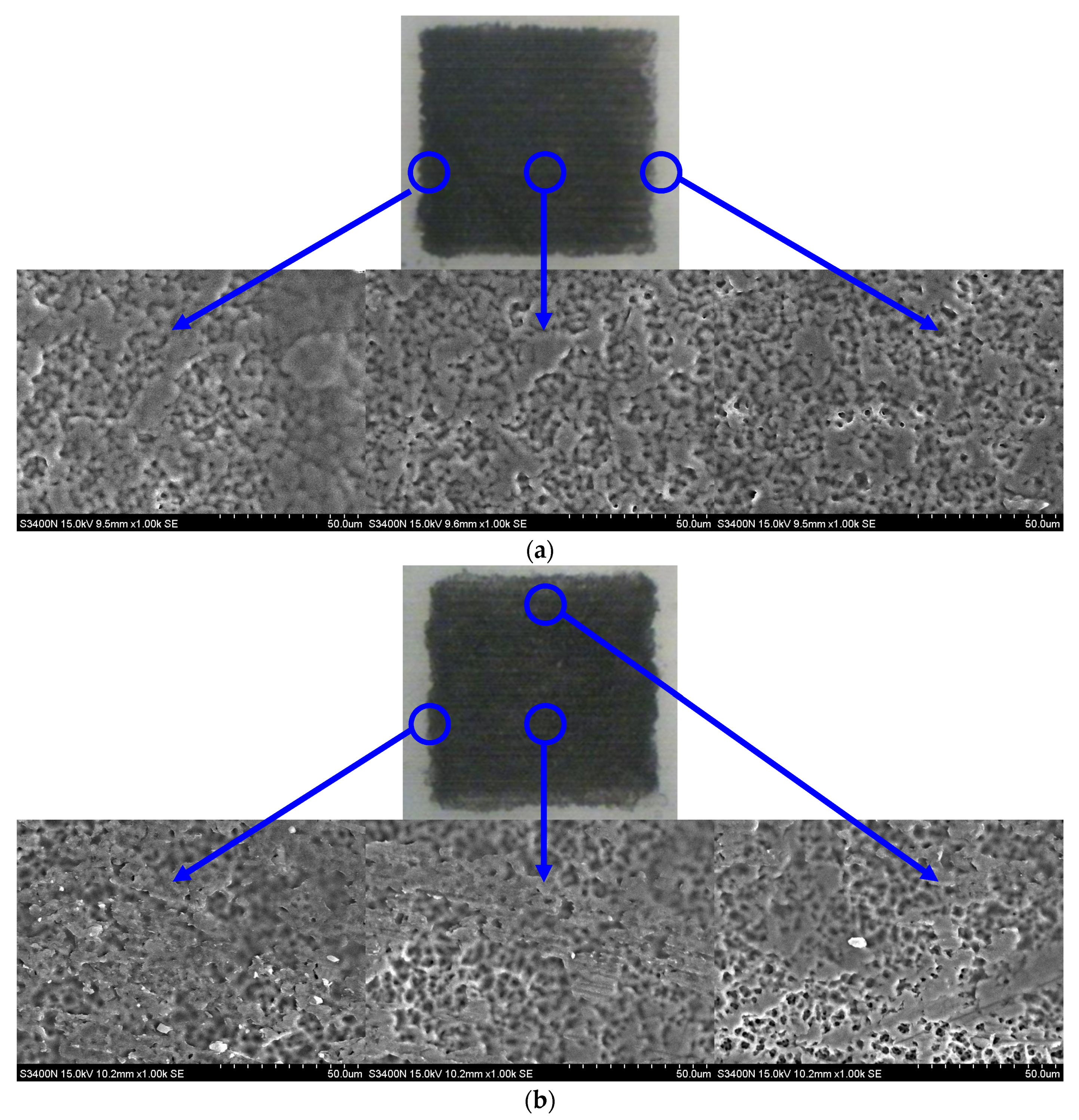
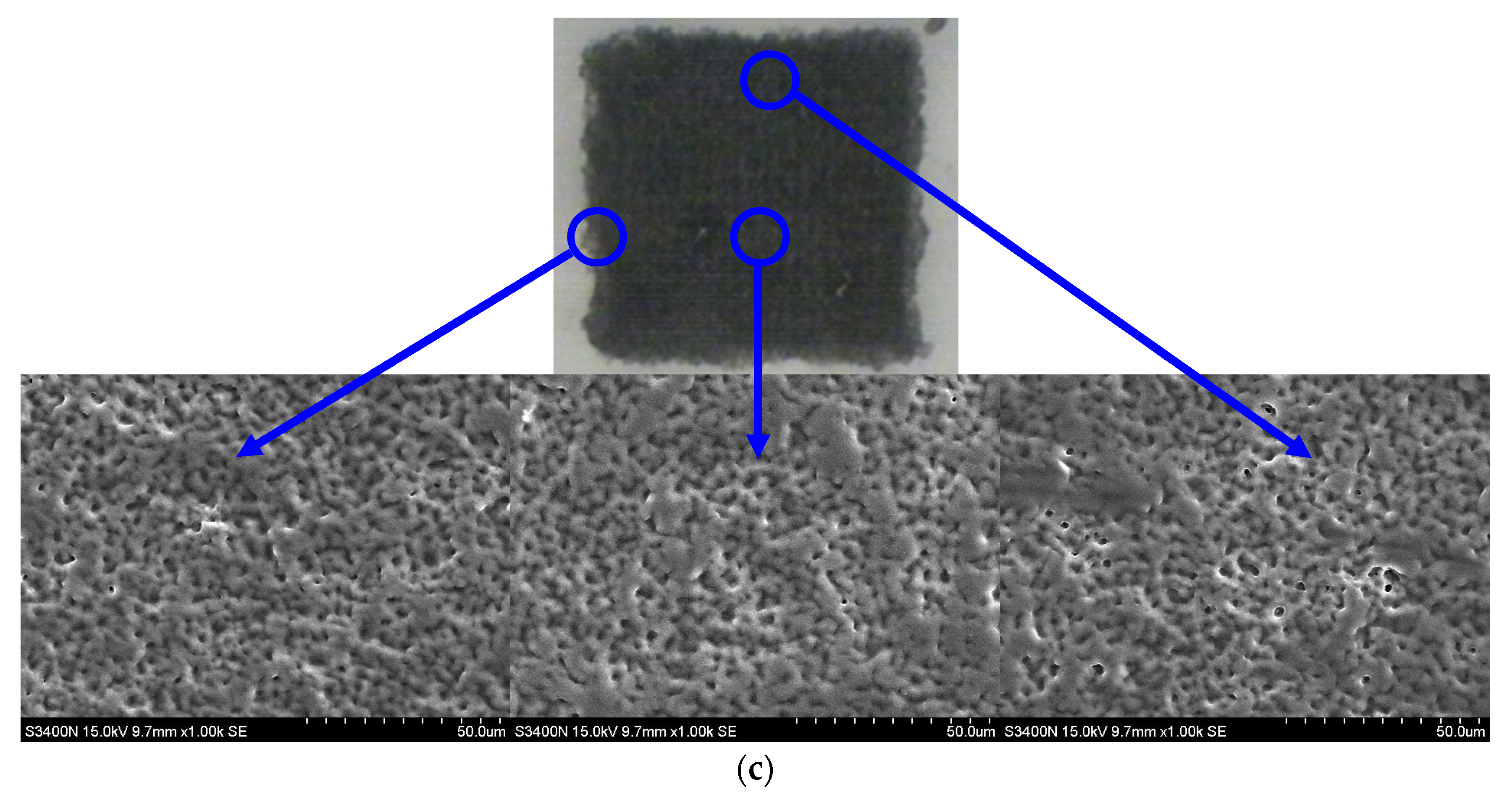



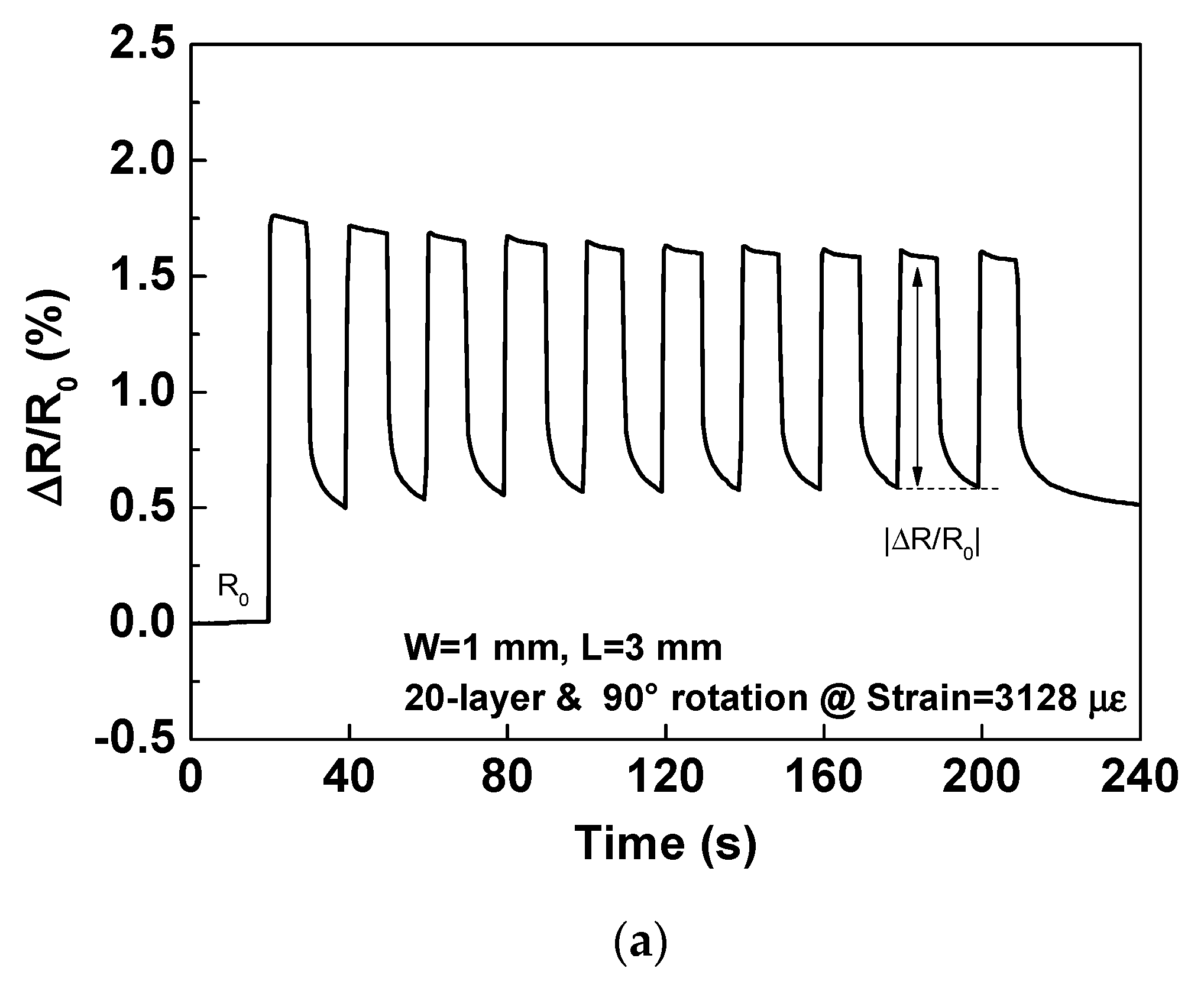
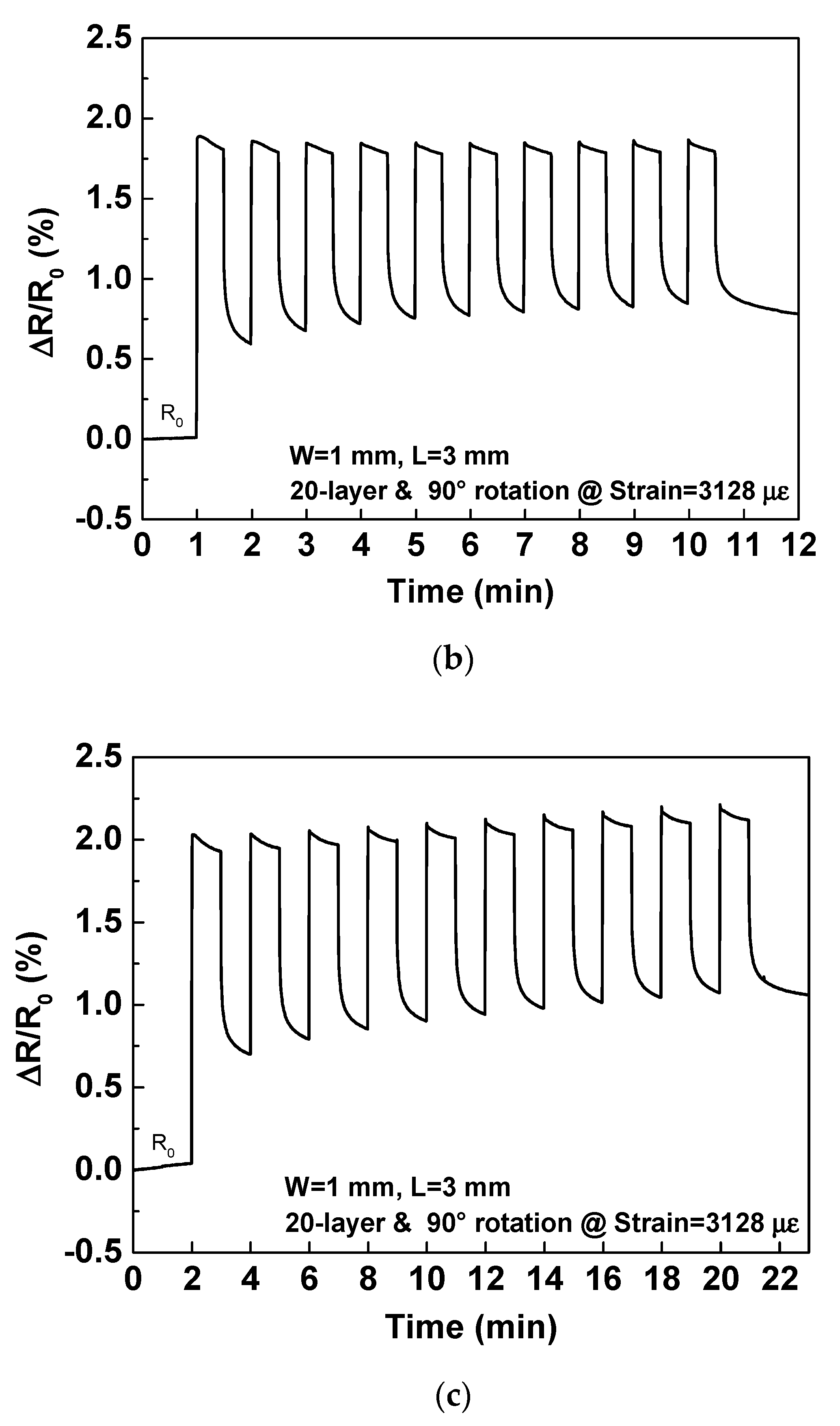
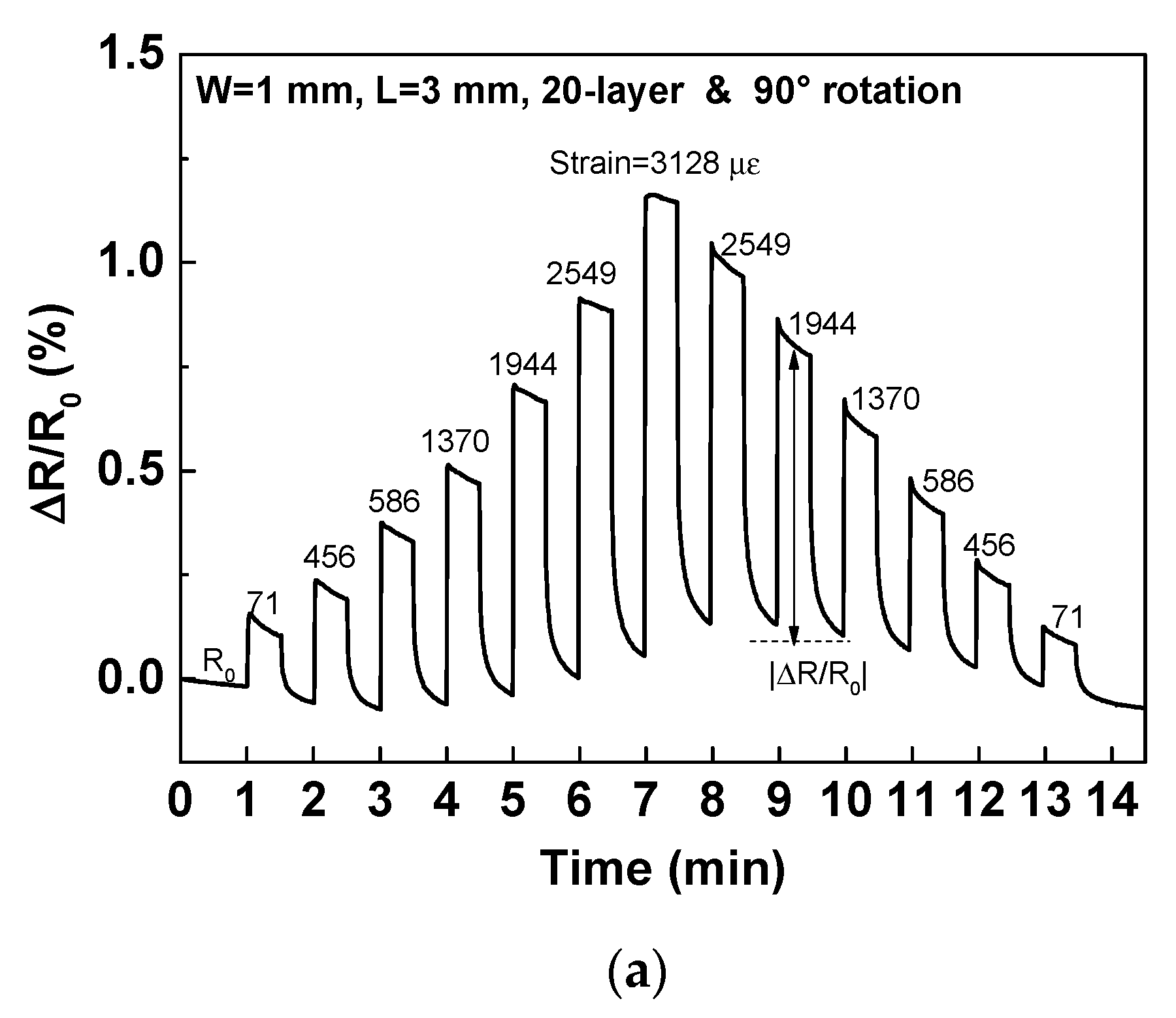

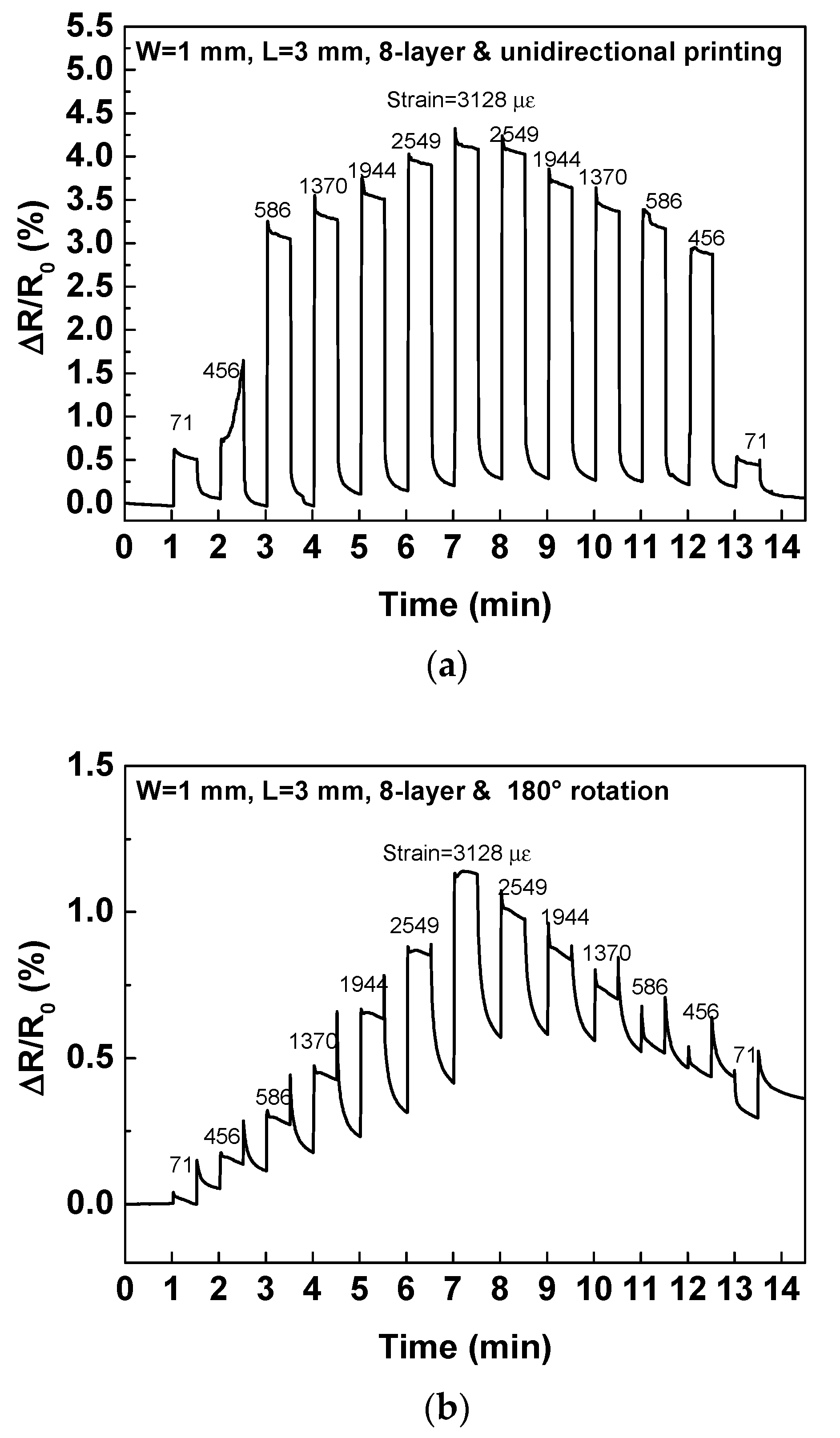
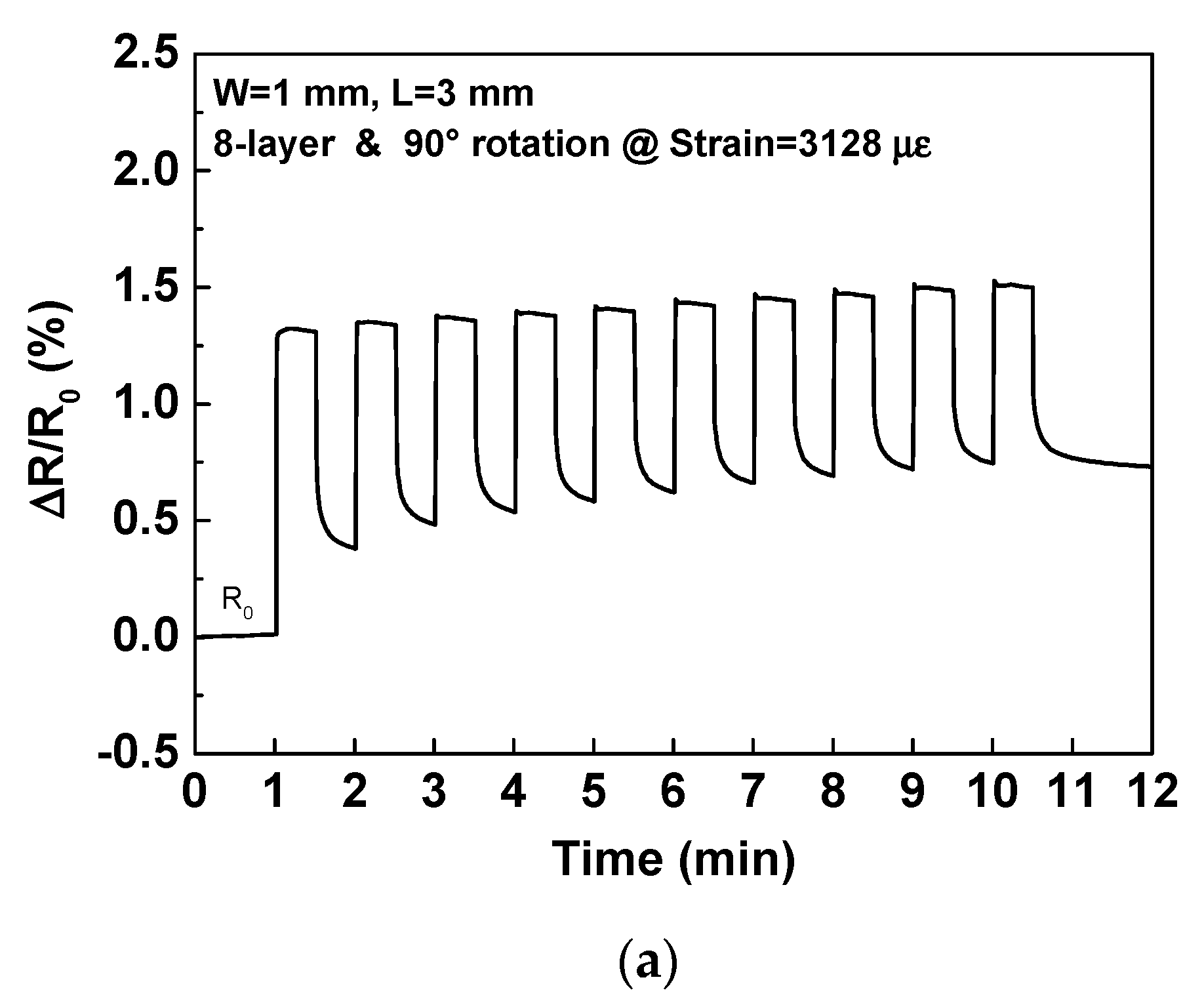
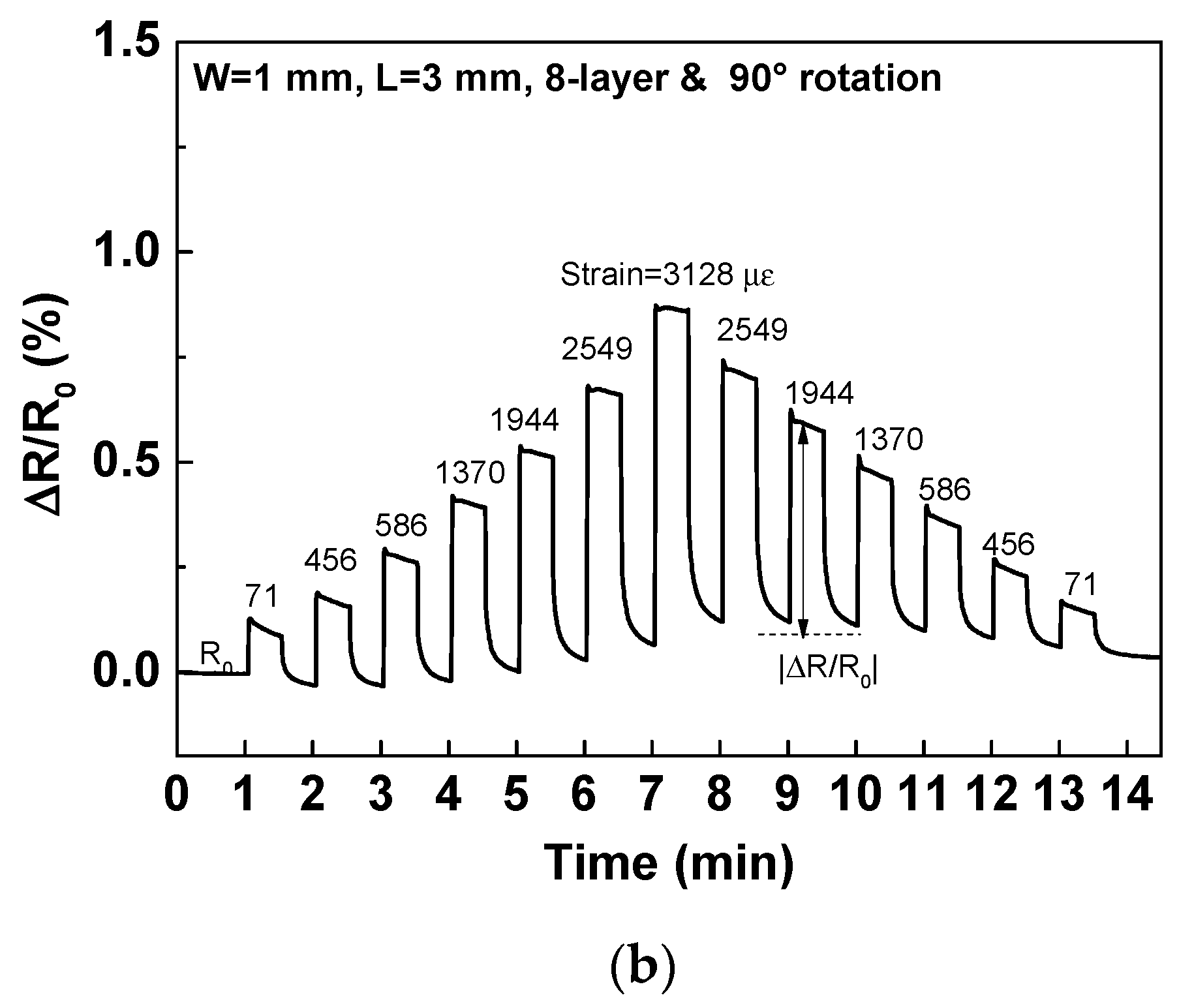
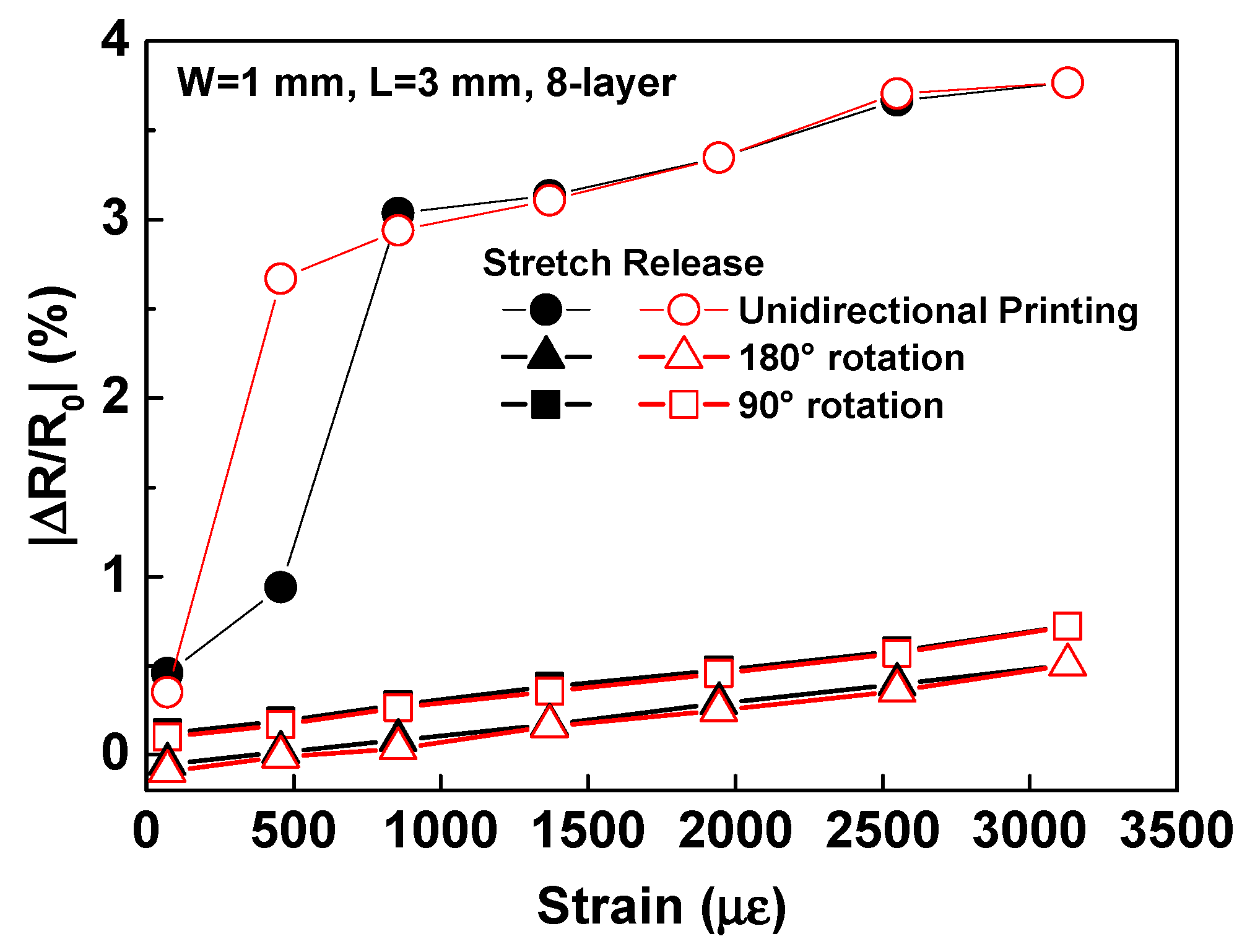
© 2020 by the authors. Licensee MDPI, Basel, Switzerland. This article is an open access article distributed under the terms and conditions of the Creative Commons Attribution (CC BY) license (http://creativecommons.org/licenses/by/4.0/).
Share and Cite
Kao, H.-L.; Cho, C.-L.; Chang, L.-C.; Chen, C.-B.; Chung, W.-H.; Tsai, Y.-C. A Fully Inkjet-Printed Strain Sensor Based on Carbon Nanotubes. Coatings 2020, 10, 792. https://doi.org/10.3390/coatings10080792
Kao H-L, Cho C-L, Chang L-C, Chen C-B, Chung W-H, Tsai Y-C. A Fully Inkjet-Printed Strain Sensor Based on Carbon Nanotubes. Coatings. 2020; 10(8):792. https://doi.org/10.3390/coatings10080792
Chicago/Turabian StyleKao, Hsuan-Ling, Cheng-Lin Cho, Li-Chun Chang, Chun-Bing Chen, Wen-Hung Chung, and Yun-Chen Tsai. 2020. "A Fully Inkjet-Printed Strain Sensor Based on Carbon Nanotubes" Coatings 10, no. 8: 792. https://doi.org/10.3390/coatings10080792




